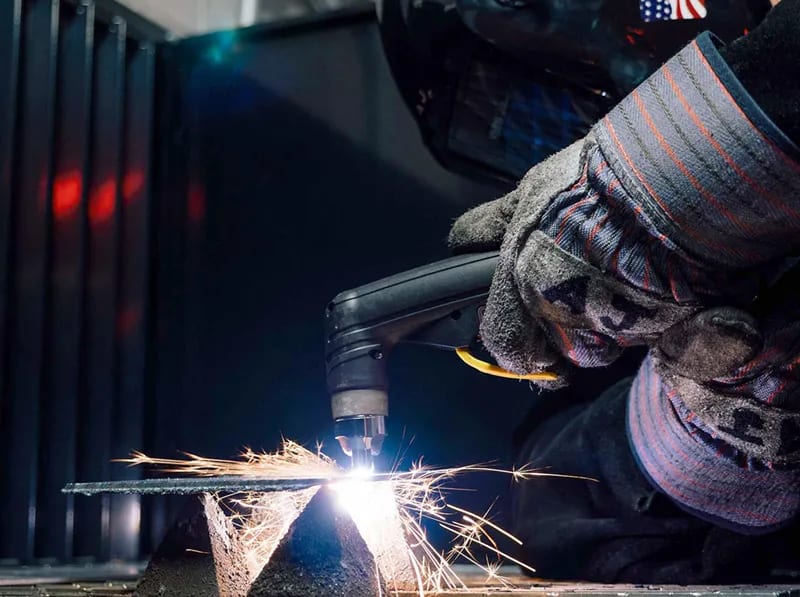Welding is part engineering, part working with your hands, and a lot of creativity and precision all rolled into one.
Welders take strong metal materials, melt them down and then use them to create brand-new structures and parts for things people worldwide depend on. Welders are responsible for making sure bridges can support cars, rockets can safely transport astronauts and cargo, cars don’t fall apart and ships ride smoothly on ocean waves.
Welders work in all types of industries and environments, from government defense and construction to manufacturing. If you enjoy hands-on work and love to build things, a career in welding could be for you.
You can use this guide to learn the answer to, “What is welding?” — plus get information on a welder's job description, welding career information, welder salary and job outlook, and how to become a welder.
What Is Welding?
Welding is the act of fusing metal parts together through heat application. Welders can complete tasks like:
- Fabricating vehicles, including cars, ships and space vehicles.
- Repairing tools, water tanks and piping.
- Completing construction tasks.
- Manufacturing farm machinery.
Welding is an integral part of the world’s biggest industries. Wherever heavy-duty metal materials are used, welding can be found.
What is a welder?
A welder is a skilled tradesperson who specializes in joining metal parts together using various welding techniques. This process involves applying heat and pressure to fuse metals, resulting in strong and durable bonds essential for constructing and repairing structures.
Given the nature of their work, welders must possess a keen attention to detail, strong hand-eye coordination and a thorough understanding of safety protocols.
Overview of welding techniques
There are various types of welding. They include:
- Flux-cored arc welding (FCAW): Flux-cored arc welding is a type of welding process in which a continuous hollow wire electrode is fed through the welding gun.
- Gas metal arc welding (GMAW): Also known as wire welding or metal inert gas (MIG) welding, gas metal arc welding is one of the most common welding processes, using an electric arc to apply heat to metal pieces.
- Gas tungsten arc welding (GTAW): Gas tungsten arc welding, or tungsten inert gas (TIG) welding, uses a non-consumable tungsten electrode to heat up objects so they can bond.
- Shielded metal arc welding (SMAW): Shielded metal arc welding is also known as stick welding, flux shielded arc welding or manual metal arc welding. It’s a manual arc welding process that uses a flux-coated electrode to form the weld.
Types of welding processes used in different industries
Welders work across diverse industries, including manufacturing, construction, automotive, aerospace and shipbuilding, contributing to the creation and maintenance of products and infrastructure. Understanding these processes and their applications is essential for welders aiming to specialize in specific industries.
In the construction and shipbuilding sectors, shielded metal arc welding (SMAW) is commonly used due to its versatility and suitability for outdoor environments.
The manufacturing industry often utilizes gas metal arc welding (GMAW), also known as MIG welding, for its efficiency and adaptability to automation, making it ideal for high-volume production.
Gas tungsten arc welding (GTAW), or TIG welding, is favored in the aerospace and automotive industries for its precision and ability to produce high-quality welds on thin materials.
Additionally, flux-cored arc welding (FCAW) is commonly used in construction and shipbuilding for its high deposition rates and effectiveness in welding thick materials.
What Does a Welder Do?
What do welders do on a daily basis?
A day in the life of a welder can be exciting and challenging because there are always new projects and related solutions. Generally, welders:
- Join and cut metal parts.
- Fill seams, indentations and holes in metal products.
- Study sketches, specifications and blueprints.
- Calculate dimensions of parts to be welded.
- Inspect materials and structures for welding.
- Use power supplies and torches.
- Maintain welding equipment and machinery.

The work of welders is physical — and hot. Welders must constantly monitor their work to ensure clean welds and avoid overheating. They must employ safety procedures at all times and be detail-oriented to produce high-quality work.
Welders have career mobility, since welding is used in an array of industries. Welding can be found in sectors like pharmaceuticals, theme parks, railroads, gas pipelines, motor sports, oil rigs and robotics.
Some welders also aspire to move into management and lead other welders. Experienced welders who have leadership qualities like communication, empathy, vision and direction can move up the welding ranks to achieve higher positions.
There are also welders who are entrepreneurial and create their own welding businesses. Whatever the industry and wherever you want to take your welding career, there are options.77
Read: HOW MUCH DO WELDERS MAKE: SALARY, TYPES & DUTIES
What Does the Welding Work Environment Look Like?
If you’ve ever wondered what a welder really does day-to-day, the answer depends on the industry, but many environments share common features. Welders often work in settings like fabrication shops, construction sites, shipyards, manufacturing plants and oil and gas facilities. Some jobs are indoors in controlled conditions, while others are outdoors in varying weather and terrain.
A typical welding work environment includes safety equipment, welding booths, metalworking tools and protective gear like helmets, gloves and flame-resistant clothing. Workspaces may be loud, hot and physically demanding, requiring attention to detail and strong safety awareness.
What do welders do on a daily basis? Tasks can include setting up equipment, interpreting blueprints, preparing metal surfaces and performing precise welds. Depending on the role, a welder job description might also involve inspecting finished work, repairing welds or working at heights or in confined spaces.
So, where do welders work? Just about anywhere metal needs to be joined or repaired, which means what welders do plays a crucial role in industries that build, power and maintain the world around us.
How To Become a Welder
Earn a high school diploma or GED certificate
The first step to becoming a welder is earning your high school diploma or GED certificate. Basic math, reading comprehension and mechanical reasoning skills are important in the field and help you succeed in welding training programs.
Enroll in a welding program - Like UTI’s
According to the Bureau of Labor Statistics (BLS), most employers prefer to hire welders who have been through training or credentialing programs. One such program is the Welding Technology program offered by Universal Technical Institute (UTI) at locations around the country.1
The BLS reports it’s helpful for welders to take courses in blueprint reading, chemistry, mechanical drawing, metallurgy, physics and shop mathematics. It’s also recommended that welders understand electricity and computers, since welding operators are becoming increasingly responsible for programming robots and computer-controlled machines.
During the welding program at UTI, students are taught GMAW, SMAW, FCAW and GTAW welding techniques. Courses cover welding safety, welding principles, engineering and fabrication, pipe welding and welding applications. Students are taught how to weld in positions including overhead, horizontal and vertical and how to work with sheet and plate metal.
Gain experience with core welding processes
You’ll need to become familiar with techniques like MIG, TIG, stick and flux-cored arc welding. Practicing these in a welding class helps you prepare for the welding work environment and understand what welders do on a daily basis.
Pursue industry certifications
Certifications, such as those from the American Welding Society (AWS), can boost your job prospects and earning potential. Many employers value certified welders, especially for specialized roles or projects with strict safety standards.
Start with entry-level jobs or apprenticeships
After training, many welders begin with entry-level positions or apprenticeships to build experience. These opportunities help you learn the trade firsthand while getting paid and are often the gateway to more advanced welding careers.
Continue learning and specializing
Welding is a career where ongoing learning pays off. As you gain experience, consider specializing in high-demand fields like pipeline, underwater or aerospace welding. Continued education and skill-building can lead to more responsibility, certifications and higher pay.
Welder Salary & Job Outlook
Welders are employed throughout the United States, with the BLS reporting the highest number of welding jobs being in Texas, California, Ohio, Wisconsin and Illinois — states with a significant manufacturing presence.
The median annual wage for welders, cutters, solderers and brazers in the U.S. was $51,000 in May 2024, according to the BLS.26 This means half of welders earned more and half earned less. Keep in mind that salary depends on several factors, including experience, employer, demand and cost of living in the area.
Industry growth and demand for welders
The demand for welders, cutters, solderers and brazers is driven by their essential role in manufacturing, construction and repair industries. Advancements in technology and automation in welding processes are expected to create opportunities for welders who possess up-to-date training and skills. Please note that the demand may vary by region and specific industry needs.
Why Become a Welder?
Strong demand for skilled welders
Welders play a key role in industries that build and maintain the world around us. From bridges and pipelines to cars and ships, skilled welders are essential to keeping things moving. As infrastructure ages and new projects emerge, many employers are looking for qualified candidates to fill open positions.
Opportunities across diverse industries
Welding offers career paths in fields like construction, manufacturing, aerospace, transportation and energy. With so many different welding jobs out there, you can choose a direction that matches your interests — whether it’s working outdoors on a job site or inside a fabrication shop.
Competitive pay and room for growth
While pay varies based on factors like location, experience and industry, many welding careers offer the potential for strong earning power over time. With continued training and certifications, some welders pursue roles in supervision, inspection or specialized welding, which may lead to higher pay and added responsibility.77
Fast entry into the workforce
Unlike careers that require a four-year degree, welding can be learned in a shorter amount of time through trade schools or hands-on training programs. For those eager to enter the workforce quickly, welding classes provide a direct path to building real-world skills.
A career built on skill, not a desk
If you enjoy working with your hands, problem-solving, and seeing the results of your labor, welding offers a hands-on alternative to traditional office work. It’s a craft that rewards precision, focus and dedication — and for many, that’s what makes it a fulfilling career choice.
Get Welding Training at UTI
If building some of the world’s most important machines, vehicles and infrastructure sounds like an appealing job to you, start welding training at UTI to learn the skills needed to pursue a career as a welder. Classes start frequently.
Learn about the UTI Welding Technology program and request information online to see if welding school is right for you.
Frequently Asked Questions
Welders are employed in a variety of industries, but the largest employers are the manufacturing, construction and transportation equipment sectors. According to the BLS, welders play a critical role in fabricating and maintaining metal structures, vehicles and equipment. They are also essential in industries such as shipbuilding, pipeline construction and aerospace.
UTI offers hands-on welding training programs designed to prepare students for entry-level welding roles.1 UTI's curriculum covers various welding techniques, including MIG, TIG, stick and flux-cored arc welding. The program also includes training in reading blueprints and welding safety, helping students develop the skills that employers are looking for. With industry-aligned instructors and job placement support, UTI can help you gain the confidence and qualifications to start your welding career.
Welding training focuses on teaching the techniques and skills needed to perform different types of welding. Training programs, like those offered by UTI, include hands-on practice and technical education. Welding certification, on the other hand, is a formal process where welders demonstrate their ability to perform a specific type of weld to meet industry standards. Certification is often required for certain jobs and is typically earned through organizations like the American Welding Society (AWS).
Yes, welders can specialize in specific types of welding based on their interests and the needs of the industry. Common specializations include MIG (gas metal arc welding), TIG (gas tungsten arc welding), stick (shielded metal arc welding), and flux-cored arc welding. Some welders also focus on niche areas, such as underwater welding, pipe welding or aerospace welding, which may require additional training and certifications.77 Specializing in a specific area can open up unique job opportunities and higher earning potential.
Is welding hard to learn?
Welding can be challenging at first, but like any hands-on skill, it becomes easier with practice and the right training. Learning to control heat, maintain steady hands and follow safety procedures takes time, but many students find it rewarding. Enrolling in a structured welding course can help you build confidence step by step.
How do I choose the right welding school?
When choosing a welding school, look for programs that offer hands-on training, experienced instructors and access to industry-standard equipment. It’s also helpful to find a school that prepares students for certification and provides career support. Touring the campus, speaking with instructors and reviewing course content can help you decide which welding classes fit your goals.

